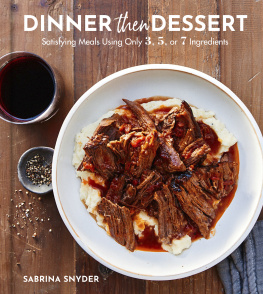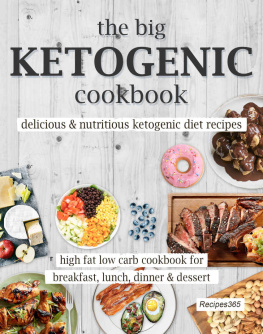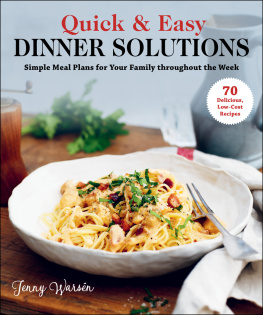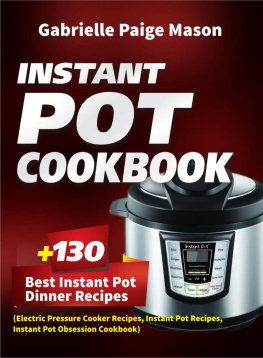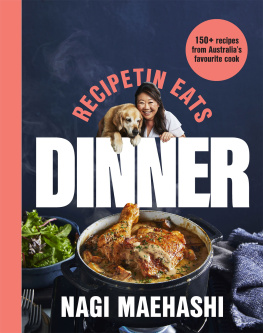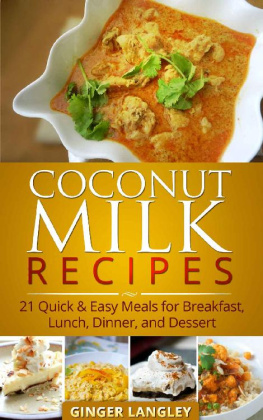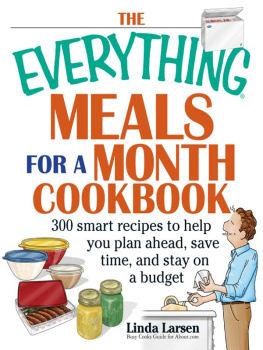Contents
Guide
For my family, youre my everything.
Contents
My Approach to Cooking
Inspiration is great, but planning is more reliable. Im a planner. And in my opinion, theres no better reflection of good planning in the kitchen than a smartly stocked pantry. Im not talking about cans of chili or chicken noodle soup that you rediscover years later and need to dust off before using, but shelf-stable components that can easily be transformed (with just a few other ingredients) into a nutritious, filling, and economical meal. We all have days when it feels like the only two options for dinner are takeout or a bowl of cereal, but if you know how to stock your pantry, a home-cooked meal can actually be faster than delivery. My hope is that even when youre short on time, inspiration, or ingredients, these recipes, which rely heavily on pantry ingredients, will be your ticket to a satisfying meal.
About Me and Dinner Then Dessert
I come to this material honestly: I feed my husband and three kids three meals a day nearly 365 days a year. Before I started my website, Dinner Then Dessert, I worked for over a decade cooking for other peoples families as a private chef. I understand that cooking every night is trickyand consistently cooking delicious food even more so. Add in dietary restrictions, picky eaters, and a lack of time, and you can feel as if youve failed before youve even started. What Ive come to realize is the secret is not about trying to reinvent the wheel every night. Its about taking foundational recipes that are tried-and-true and then layering in new and interesting flavor combinations. Starting with workhorse recipes like roast chicken and meatloaf, crowd-pleasers like cheesy baked pasta, and time-savers like slow-cooker chili, I test and retest them until theyre perfect, then I add fun twists like BBQ chicken to mac and cheese, or Indian curry to meatballs. The recipes in this book are practical and flexible. Theyre also flavor-packed and fun.
I started Dinner Then Dessert because my clients were always asking for my recipes and I liked the idea of creating a resource where they could all be housed in one place. Designing and perfecting new recipes is my passionnothing quirky or idiosyncratic, just reliable and highly tested. I take my cues from Americas Test Kitchen and Serious Eatss Food Lab; Im systematic and scientific in my approach, and I make sure that the recipes I give my readers are easy to follow and make. Cooking alongside clients for so many years, Ive seen just about every conceivable food fail, some more surprising than others. I always try to put myself in the kitchen with my readers, thinking about where their questions might come up, where they might get stuck. And if one of these recipes becomes a favorite, you will inevitably tire of itthats why I give so many variations. Now you have multiple ways to make adjustments to it, either because you might be missing an ingredient or just want to mix it upensuring that you keep it in regular rotation.
Growing up in California, I spent hours watching Yan Can Cook and Wolfgang Puck, scribbling down recipes, then racing into the kitchen to re-create Martin Yans beef stir-fry or practicing Wolfgangs technique for julienning vegetables. I loved being able to make small tweaks to flavors or cooking times and see big changes in the end result.
When I worked as a private chef, I often had to make a different meal for each member of the familyeach with their own dietary restrictions or food preferences. And Id often be preparing these several hours ahead of dinnertime, so the food would need to keep and reheat well. I loved the challenge, but I now had my own family to think about. So, with young kids at home, I needed a job that could accommodate my schedule. Dinner Then Dessert was born.
How This Book Is Organized
At its core, this book is intended to inspire and teach people to stock and cook from their pantry. Ive devoted of the book to listing and describing the ingredients that I turn to most often. I strongly believe that any item that takes up space on my pantry shelf should have multiple uses, so I try not to call for any ingredients that get used only once. Along with shelf-stable pantry items are perishable itemsthe meat and poultry, seafood, dairy, and fruits and vegetables that I use most often in my cooking. Among these are chicken thighs and breasts, larger cuts of meat that can be slow-cooked in advance, and bacon (which is a powerhouse in the kitchen for instant flavor). My hope is that working with a slightly pared-down assortment of ingredients will build your confidence. You will learn how each ingredient behaves in the kitchen, how long it needs to get tender and whether it can handle high heat, which flavors are complementary, and so on. From there you can make your own swaps and improvisations.
of the book is broken down into three chapters on dinners (plus one on desserts), organized by the number of basic ingredients each recipe requires3, 5, or 7. These numbers dont include oil, butter, or salt and pepper. Since shopping for a recipe is often the biggest roadblock to cooking, my hope is that these very simplified recipes remove that obstacle. If you have other herbs or vegetables that you want to throw in, by all means do it! But know that even without any extras, you can still make a delicious meal. Within each chapter, Ive organized the recipes according to the most common and stress-free cooking methods: quick cooking on the stovetop, longer braising or using the slow-cooker, and baking. At the end of each section are easy side dishes that can be mixed and matched with other recipes in the book.
Sprinkled throughout the book are recipes that I consider foundational recipes. These are classics like roast chicken, pot roast, meatloaf, and roast pork loin. They are easy enough to make any night of the week but can also be dressed up and served to company. For these, I devote a bit more space to describing how to perfect your technique, and I give more ideas for additional seasonings and embellishments.
Finally, desserts, which are similarly organized by number of basic ingredients. Ive included some of my favorite recipes here, ranging from brownies that can be decked out in a million different ways for the numerous bake sales you may have in your life to impressive mousses and pies destined for the holiday table.
How to Use This Book
While this book begins with a list of pantry staples, I certainly dont expect you to go out and buy everything on that list before getting started. Instead, I recommend studying your familys eating habits so you know how much you use various items. And then take a look at your pantry. Maybe there are things you buy that never seem to get used. What do you already have, what can you toss because its been there for a decade? There is often a disconnect between how we would like to cook and eat and how we actually do, but it is not an impossible divide. Looking to incorporate more fruits and vegetables? Start with a few new additions. Or, if youre interested in incorporating more Asian or Latin American flavors into your cooking, try a shelf-stable sauce or condiment or two; Ive listed some of my favorites.

